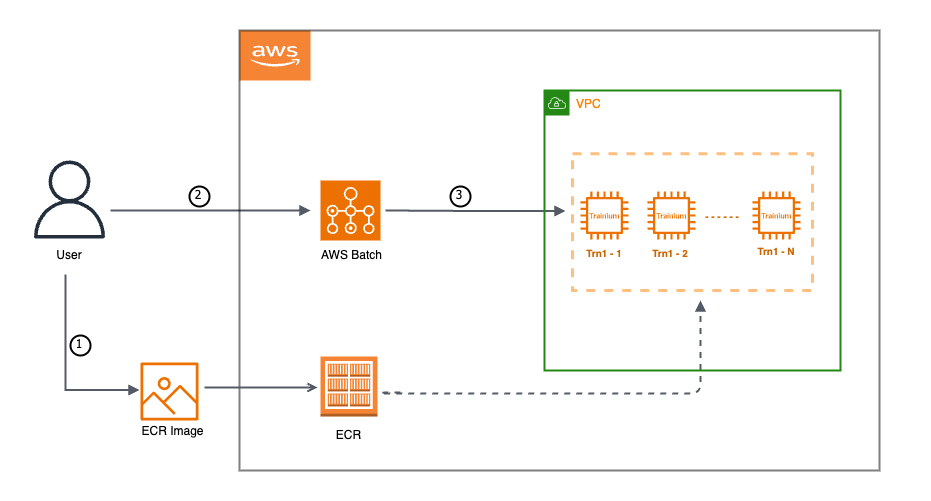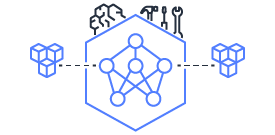This document is relevant for: Inf2, Trn1, Trn2
Train your model on AWS Batch#
Description#
AWS Batch provides a scalable and cost-effective solution for running batch computing workloads in the AWS Cloud. Integrating Trainium with AWS Batch provides an efficient and cost-effective way of training deep learning models at scale. Once you configure your training job, AWS Batch effectively manages the orchestration, execution, and dynamic scaling of compute resources for your extensive machine learning workloads. To learn more about AWS Batch, see here.
How does AWS Batch work with Trainium#

As depicted in the illustration above, our workflow begins by building a Docker container image for Trainium and pushing it to Amazon Elastic Container Registry (ECR). Following this, we configure our AWS Batch environment with the required capabilities, and subsequently submit the training job.
Please follow the below mentioned steps to run your training jobs on AWS Batch with Trainium.
Before you begin, please ensure that you have the following prerequisites completed:
AWS VPCwith at least oneSubnetandEFA Enabled Security Group(learn more about EFA-enabled security group here). Please make sure subnet needs to be private, and the VPC needs to have a NAT gateway to allow internet connectivity for the private subnet.AWS ECRrepositoryAWS CLIinstalled and configured with permissions for the above mentioned AWS resourcesDockerjq
Setup to start working with AWS Batch
Connect to your EC2 instance(
x86_64-based Linux instance) and clone theaws-neuron-samplesrepo. Once done, navigate to aws batch scripts directory.cd ~/ git clone https://github.com/aws-neuron/aws-neuron-samples.git cd ~/aws-neuron-samples/torch-neuronx/training/aws-batch/all-reduce
Configure resource requirements
Update the
build_configs_and_setup.shwith your environment variables. Once done, execute the bash script using the command./build_configs_and_setup.sh.Build the required docker image and publish it to ECR
Run
./build_docker_image.shto build a Neuron Deep-Learning Container image using the latest Neuron packages and push this image to ECR.Prepare the AWS infrastructure required to submit the batch job
Run
./create_resources.shto create all AWS Batch resources needed for your training workload. Below is the brief description of various AWS Batch components this script will create for you -Placement Groupenables you to influence the placement of your EC2 (Elastic Compute Cloud) instances within the AWS infrastructure.Launch Templateallows you to define a set of instance configuration parameters, including the Amazon Machine Image (AMI), instance type, key pair, security groups, and other settings, in a template format.Compute Environmenthelps you to specify configuration that specifies the type of compute resources you want to use for your batch jobs. It includes details such as the EC2 instance types, the minimum and maximum number of instances, the VPC configuration, and other settings related to the compute environment.Job Definitionis a blueprint that specifies how a batch job should be run. It encapsulates information about the job, such as the Docker image to be used, the command to execute within the container, the CPU and memory requirements, job dependencies, and other settings.Job Queueacts as a queueing mechanism for managing and scheduling the execution of batch computing workloads. By using job queues, AWS Batch provides a scalable and efficient way to process batch workloads, managing the allocation of resources and ensuring optimal use of compute capacity.
Submit the job to AWS-Batch
Run
./submit_job.shto submit a basic all-reduce job in the provisioned AWS Batch environmentMonitor the AWS-Batch job
You can use Amazon CloudWatch Logs to monitor, store, and view all your logs from AWS Batch job. To learn more about it, please see here.
Note
You could run a full model training job using this setup. For example, this sample runs the Llama2-7B tutorial on AWS Batch using the same setup.
You can further tailor your
Dockerfileto include any additional dependencies specific to your needs.You have the option to leverage
trn1n.32xlargeinstances as an alternative totrn1.32xlarge. To make this transition, you only need to make adjustments to thelaunch templateandjob definitionin order to accommodate the use of 16 EFA (Elastic Fabric Adapter) devices, whereas the current setup fortrn1employs 8 EFA devices. Please check out this document to start withtrn1n.32xlargefor multi-node execution.
This document is relevant for: Inf2, Trn1, Trn2
